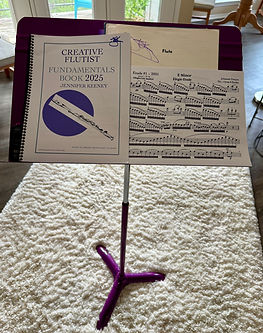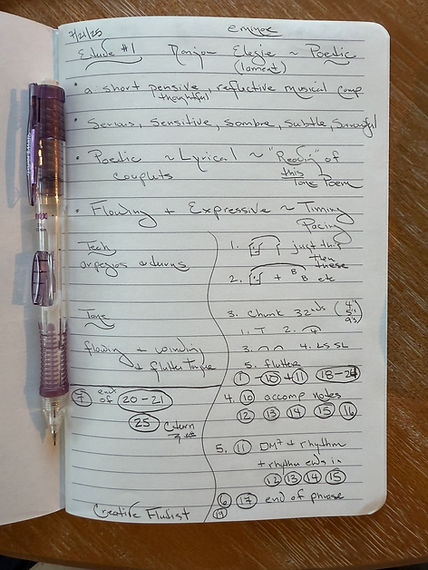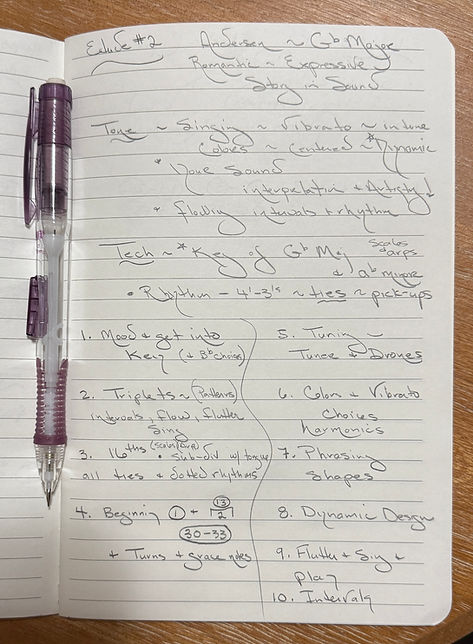All- State Flute Etudes


Julee Kim Walker - flute professor Texas A&M Commerce has selected the etudes coming out July 21, 2025.
Here is her YouTube Site to listen and watch her Videos on preparing the All -State Flute Etudes. You can also sing up here via TMEA for Videos
Here is a link to order your copy of the Etude Book
Here is the link to TMEA Etudes to check errata and see select Etudes.
Creative Flutist Ideas for Practice on Etudes
Will Update Each Week
Creative Flutist Listening Playlist For TMEA Flute Etudes on YouTube
Etude #1: Élegie ~ Donjon
quarter note = 52-66
Key: e minor
Composer & Style:
This is an Élegie, a poem of serious reflection... it's lamenting, nostalgic mood and character, and is poetic and lyrical. It is based on the elegiac couplets style of poetry.. Here is a part of a poem by Jean Richepin (1849 - 1926) that is written on the top of the Salon Etude by Donjon that we are playing. It is in French and here is the English translation: the part in bold is on the top of our original Etude. His poems were set to music and this may give us more inspiration for this etude.
12. Winter's day
Jean Richepin (1849 - 1926)
The sky is numb.
On the naked earth
The snow has come...
On my heart too.
In the darkened air
The last leaves
Roll in the ruts.
My happiness too.
It is cold here.
The quails, the thrushes,
Have left our shores.
My mistress too.
Etude #2: Andersen GbM, Pastorale
quarter note = 56 - 64
Key: Gb Major
Composer & Style:
Opens with a fantasy fermata in a forest green Gb home key. We enter this etude in Tranquility, in the softness of a forest’s green moss carpet, (piano dynamic) and then we are given the freedom to ascend freely before beginning the flowing long lines telling us a story in sound, that is for you to interpret...
Style: Danish Composer, Flutist, Conductor, Joachim Andersen was born 1847-1909. He wrote 8 volumes of etudes for flutists and we play these wonderful etudes our whole life.
The style is virtuoso “Romantic” flute playing that always helps us get to know our instrument and playing.
Come up with your own colors or borrow from the forest green, nature song I have suggested. What matters is that you connect to coloring your sound, using your artistic imagination, your harmonic content, dynamics, vowels and vibrato. I would encourage you to use your tuner on drones, also create Fermata’s especially on Db’s, to check intonation that way too. Make up some harmonies and play with friends too.
There are many printed dynamics to follow and to shape. In between the printed dynamics, make sure to create your unique dynamic design for this expressive, romantic etude.
I like to think of the articulation as the diction, the poetic pronunciation for each line, each phrase of music. How does each “stanza” begin, where does it go and how does it end? Choose your articulation with care and consideration. Using a variety of tu, du, tah, dah, poo, pah and between the lips French style too.
This is in a flowing 3/4 that not only sings but dances as the wind does too. 1 23 1 in general one is given the most emphasis (the love, weight/expression) 2 is flowing to 3 and 3 is an uplifted beat that leads to 1. Shape the meter and also notice were it varies from this kind of contour.
The rhythm is complex in this as it changes a lot but needs to sound flowing, smooth, free, singing while at the same time precise as well as all of the FREEDOM we have in the all Fermati, Rall, Lento, a Tempo. Practice singing, saying, moving, conducting away from your flute to feel and express the rhythms and music. Use your metronome to keep a steady pulse, heart beat and to be true to the written rhythms too. As well as to creating the push and pull, taking time to~ rubato ~ timing that expresses the beautiful phrases of this Sound Story.
Express the Form: We are not playing the entire etude. The from is basically an introduction, theme that are developed, a bridge Lento, and then a return to the fantasy, green forest land, tranquil opening that started with.
Etude #3: Karg-Elert Caprice op 107/9
Dotted quarter note = 60-68
Key: G Major
Composer & Style:
Sigfrid Karg-Elert's "30 Caprices for Flute Solo," Op. 107,
is a set of challenging etudes for flute, widely recognized as a
staple in flute pedagogy. These pieces are designed to develop
technical skills, Including linear thinking, dynamic control, and
phrasing, and are frequently used in auditions and competitions.
Key aspects of the Karg-Elert Flute Etudes:
-
Purpose:
The etudes were originally written for a flautist friend serving in the war, aiming to provide technical challenges and prevent boredom.
-
Technical Focus:
They address various technical aspects of flute playing, such as articulation, finger technique, and embouchure.
-
Musicality:
Beyond technical demands, the etudes require musical expression and stylistic awareness.
-
Chaconne (No. 30):
This particular etude is a concert etude known for its complex combination of technical requirements and musical depth.
-
Pedagogical Value:
The etudes are valuable for developing technical flexibility and musicality in advanced flute players.
-
Common Use:
They are frequently used in flute auditions and competitions, including all-state auditions.
-
Structure:
The collection consists of 30 individual caprices, each with unique technical and musical challenges.

Practice Ideas

Practice Ideas




